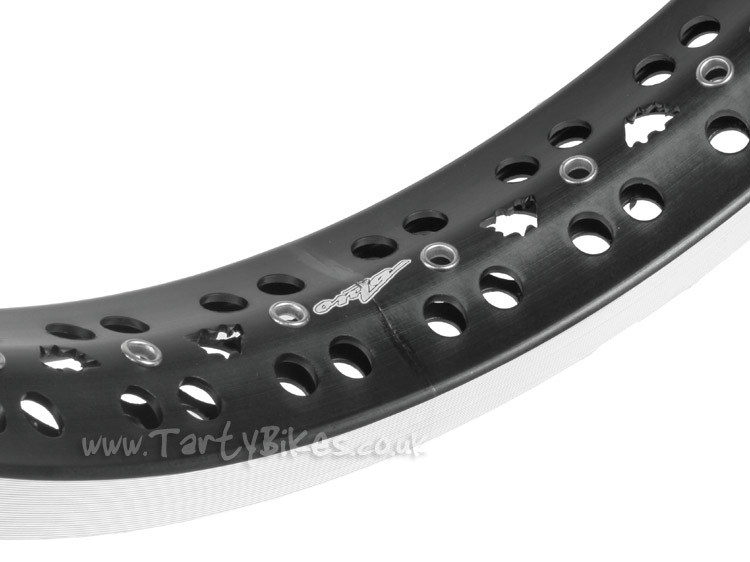Hey
As you might know, I am a Trials rider (bike) that got into unicycling through a local friend who already did Uni trials. All this time, I was fascinated by the amount of components crossed over from both sports. Uni trials borrowed heavily off biketrials components, especially in the wheel area.
However, there lies a small kink. 32h rims and hubs have been the ‘standard’ in biketrials for many many years now, with all the top brands (Echo, Koxx, Monty, Onza, and countless others) pumping their latest rim innovations into the 32h market. We, in unicycling use 36h, which is very very rare in biketrials. Only a small handful of rims are in 36h, and most of them are generic and weak designs that haven’t been changed for around half a decade.
Before, I thought it’d be good to encourage biketrials brands to produce their best rims in 36h, but it just isn’t happening. Why? For various reasons:
-Rims come in various colours and models for each brand, and making 32h AND 36h would just add to costs, and lead to surplus in many cases
-36h is not profitable in the biketrials world since pretty much 99% of biketrials hubs are 32h.
-36h drilled rims are actually structurally weaker than 32h, those of you who’ve snapped the thin joints of metal between the spoke hole and large hole on the inner wall of drilled rims know what’s up.
-^This issue here is less of a problem on 32h rims, MUCH less of a problem, since there are less spoke drillings, this allows the ‘gap’ between the spoke holes and larger dirlled holes to be wider, so it’s far more resistant against snapping pieces off.
-36h adds 4 more spokes than 32h, obvious isn’t it? But for those weight weenies out there, 4 spokes can add a lot of weight.
Thus, I propose that 32h hubs to become another common standard in unicycling:
-32h really isn’t much weaker than 36h at all. A good quality wheelbuild and careful maintenance on occasion will keep a 32h wheel intact, pretty much what you’d do with ANY wheel really?
-32h hubs will instantly open up a myriad of new options to choose from in the biketrials world
-For the new KH 2009 hubs, it’s ideal since the new aluminium flanges are separate pieces. So surely, Kris, could you not order the factory to drill some of these flanges 32h instead of only in 36h? It shouldn’t cost any more than usual since you don’t need any special custom moulds.
Here are some new rims people will be able to ride with once 32h ISIS hubs are available:
Echo 2009 CNC SL rim:
Onza 128 rim
Weight: 481g
INFO: http://www.tartybikes.co.uk/product.php?product_id=10567&category_id=517
Onza Pro Series rim
Weight: 435g
Try-All hOle rim (NB: single wall rim!)
Weight: 437g
Info: http://www.tartybikes.co.uk/product.php?product_id=10653&category_id=517
Monty 221Ti rim
(This rim isn’t titanium despite the name. The name is derived from it coming built on the Monty 221Ti bikes where it features small titanium parts like bolts, spokes, etc…)
Weight: 427g
Info:
I know that Koxx-One are planning on releasing a 32h hub of theirs already, but talks of 32h hubs have exchanged between Roger Davies and Joe Hodges in the past too. It’s really not a bad idea at all, and it holds up to the harshest biketrials riders to this day. I know people will say unicyclists put more stress on the wheels… Well, in trials, that is highly debateable. Both sports put huge stress on the 19" wheels. You see all those riders like Neil Tunnicliffe, Craig Lee Scott, Damon Watson, and the Koxx team on YouTube yeah? Well, they all use 32h rims. Sure there are breakages, but hell, 36h would not hold up any better. Quality of the wheelbuild is crucial though.
At the same time, 32h is the standard on MTBs as well, yep, the DH, Dirt Jump, Freeride, Northshore, pretty much everyone’s using 32h there. (Suspension doesn’t save their wheels, incase you thought so)
It’s not going to work by getting biketrials manufacturers to make 36h rims. No way, they just won’t do it for the reasons I pointed out earlier in the post. However, just producing 32h hubs in unicycling won’t be very hard. This’ll add to the weight reduction craze that many people have going, and it isn’t that much of a strength penalty either. It’s still strong enough, don’t let the number fool you.
Here’s another external benefit: With the introduction of 32h hubs, this’ll mean uni riders will start buying up the various 32h rims on offer, which mean trials retailers are getting better support, and the actual brands are getting more profit and popularity by having a whole new world of riders thrusted into their market. By economic theory, this’ll lead to “abnormal profit” which in turn can be used for better R&D purposes, which in future can lead to even more innovative products. Overall, this’ll be doing the entire trials world a favour.
Kris, if you could consider this option, it shouldn’t be any more expensive than producing your 36h hubs in theory!
Thanks for reading
![]()
EDIT: Also, for those riding 24 or 26", this’ll also open up a lot of options in the MTB world too. The rims tend to be narrower than trials-derived rims, but the quality is far far far higher than that of any trials rim, without a doubt.



 i would def buy one
i would def buy one